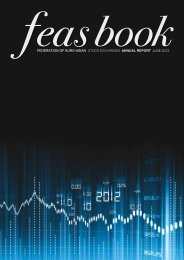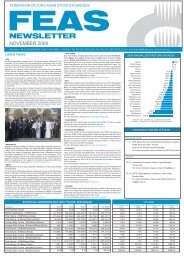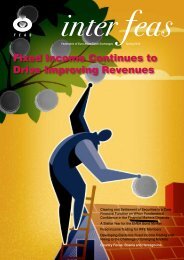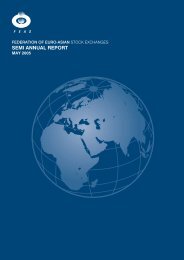Download - FEAS
Download - FEAS
Download - FEAS
- No tags were found...
Create successful ePaper yourself
Turn your PDF publications into a flip-book with our unique Google optimized e-Paper software.
FEDERATION OF EURO-ASIAN STOCK EXCHANGES ANNUAL REPORT JUNE 2010“TOSHKENT” REPUBLICAN STOCK EXCHANGEECONOMIC AND POLITICAL DEVELOPMENTSEconomic and Political EnvironmentMr Karimov dominates the political scene, andthere is little prospect of democratisation overthe forecast period. Mr Karimov, who was lastelected for a seven-year term in December2007, is expected to maintain a firm grip onpower, as there seems to be no co-ordinatedopposition to his rule from within the politicalhierarchy. Furthermore, years of repressionhave prevented the emergence of anopposition figure capable of challenging himsuccessfully. Most of his opponents are livingin exile.Relations with the US and the EU haveimproved from a low in 2005, driven by antiterroristinitiatives, the regional securityagenda, the small steps taken by the Uzbekauthorities towards tackling human rightsconcerns, and the desire of some EU states tolook for alternative energy sources in CentralAsia in order to reduce their reliance onRussia. The EU has dropped its sanctionsregime against Uzbekistan, but human rightsorganisations will continue to press for atougher stance. The West will continue to haveonly limited leverage over Uzbekistan in thisarea, in part because the country does not relyon substantial support from Westernmultilateral financial institutions, and haslimited trade with the region. Most Westerninvestors will remain deterred by the difficultbusiness environment, and Chinese andRussian firms are likely to provide the bulk ofany foreign investment. The US is set tobecome a more prominent partner in antiterrorismmeasures, following an agreement toallow US non-munitions supplies toAfghanistan to transit Uzbek territory. Relationswith Russia and with Uzbekistan's immediateneighbours in Central Asia will be tense,particularly in view of recent violent incidentson the border with the Kyrgyz Republic andbecause of Uzbek anger over Kyrgyzagreement to host a second Russian militarybase, possibly close to the Uzbek border.There is also a serious risk that insurgents inAfghanistan–among them significant numbersof ethnic Uzbeks–could expand their activitiesto include Uzbekistan. Ongoing disputes overwater and energy supplies will also exacerbatetensions between Uzbekistan and itsneighbours.Over the forecast period the government willmake greater efforts to support growth in acontext of external shocks, by expandingpublic investment into infrastructure andindustry, and by increasing public-sectorwages and social payments. Althoughimportant advances have been made in somepolicy areas–notably, Treasury reform, areduction in the tax burden and increasedcapitalisation of banks–the pace of structuralreform remains slow.Economic PerformanceAlthough Uzbekistan is relatively immune tothe turmoil on global financial markets, it isbeing affected by the global economicslowdown. The chief external factors affectingeconomic performance are trends incommodity prices. Following an estimated riseof 10% on average in 2009, gold prices are setto rise by 9% in 2010, before falling by 6.5% in2011. In 2010 demand for cotton will rebound,following the end of the global recession, withprices expected to rise by 15%. The remittanceinflows on which many Uzbek households relywill decline, owing to slower economic growthin Russia and Kazakhstan, the maindestinations for Uzbek migrant labour.Official data continue to be highly suspect andinternally contradictory, and the authorities'sanguine view of the economy is underminedby the continuing policy emphasis on "anticrisismeasures". officially reported growthrates will continue to exaggerate the true rateof economic expansion, and that theauthorities will report headline full-year GDPgrowth rates of close to the official target. Theauthorities expect real GDP to expand by 7-8%in 2009, and have reported growth of around8% in the first half of the year–a slowdowncompared with the year-earlier period. Growthis forecast to pick up to 8.1% in 2010 and8.3% in 2011 as export markets recover. Theeconomy will also be assisted by risinginvestment, mainly funded by governmentexpenditure, as well as by some FDI fromChina and Russia. Private consumption willsuffer from a moderate decline in remittances,but will be sustained by government efforts toincrease wages and social payments.Based on historical inflation figures from theIMF, annual average inflation is expected at8.6% in 2009. The authorities will continue toattempt to limit inflation by the imposition ofprice controls on basic foodstuffs and energy.Lower global commodity prices brought downinflation in 2009, but this trend will be reversedin 2010-11. A continuing depreciation of thelocal currency will also boost importedinflation. Robust money supply growth–aseconomic growth picks up, and as thegovernment increases wages and benefitsfurther–will also fuel inflation over the forecastperiod.The authorities will continue to target a slowpace of nominal depreciation in order tosupport export competitiveness, particularly inview of weakening demand for Uzbek exportsas the Russian and Kazakh economies slowsharply. However, the pace of depreciation willbe faster than in recent years. A globalweakening of emerging-market currenciesagainst the US dollar since October 2008,owing to greater risk aversion, resulted in anacceleration of the trend of som depreciation.The Uzbek currency was also affected bycontagion from the steep falls in the Russianrouble and Kazakh tenge. By end-September2009 the som had depreciated by 12% sincethe end of September 2008. Downwardpressure on the currency will remain becauseof lower inflows of foreign exchange fromexport receipts and remittances.The current-account surplus is in 2009 atUS$4.6bn, or 15.6% of GDP, smaller than thesurplus of US$6.3bn (22.4% of GDP) recordedin 2008, owing to a downturn in exportrevenue. The State Statistics Committeereports lower figures for the current account(for example, it reported a surplus of US$4.1bnin 2008), but uncertainty surrounds officialfigures for the services account and for inflowson current transfers.** The Economist Intelligence Unit Limited, November 2009Key Information ContactsState Property Committee www.spc.gov.uzMinistry of Finance www.mf.uz/engNational Bank of Uzbekistan http://eng.nbu.com/about/history/index.phpState Central Securities Depository www.deponet.uz/english.shtmlPortal of the State Authority www.gov.uz/enPAGE 156
















